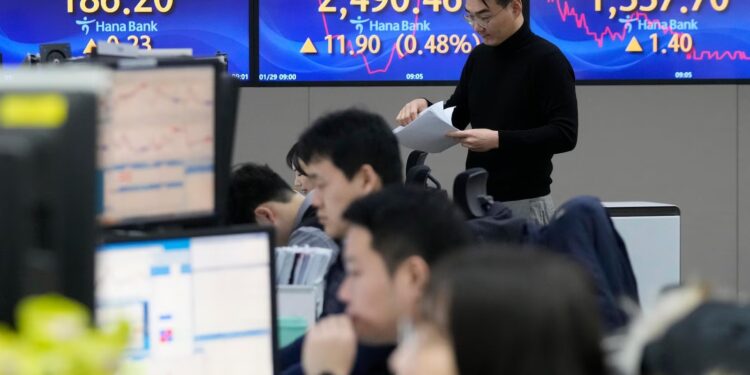Asian stocks are mostly higher after Japan and China reported data reflecting relatively sluggish growth for Asia’s two largest economies
Asian stocks were mostly higher on Monday after Japan and China reported data reflecting relatively sluggish growth for Asia’s two largest economies.
The euro rose after the far-right National Rally gained a strong lead in first-round legislative elections, while the Japanese yen fell, trading at about 161 yen to the dollar. U.S. futures and oil prices rose.
Polling agencies suggest the National Rally might win a majority in the lower house of the parliamentary, but the outcome is uncertain and the voting system is complex.
The euro cost $1.0757, up from $1.0713.
U.S. futures and oil prices rose.
Japan’s benchmark Nikkei 225 added 0.3% to 39,693.29 after a quarterly survey by the Bank of Japan, called the “tankan,” showed a modest improvement in confidence among the country’s largest manufacturers in the April-June quarter.
However the government downgraded its estimate for growth in the first quarter of the year, to a minus 2.9% annual rate from the earlier figure of minus 1.8%.
“Across all industries and firm sizes, business conditions held steady at 12, which is on past form consistent with (quarterly) GDP growth of around 0%,” Marcel Thieliant of Capital Economics said in assessing the tankan. “A renewed slowdown in GDP growth this quarter would be consistent with the slump in industrial production firms were predicting for June.”
The Shanghai Composite climbed 0.3% to 2,976.64 after a survey of factory purchasing managers reported over the weekend showed conditions remained in contraction for a second straight month.
But a similar private-sector survey of manufacturing activity released Monday showed an improvement in business conditions. The Caixin Manufacturing PMI rose to 51.8 in June on a scale up to 100, compared with 51.7 in the previous month. Readings above 50 are considered to show an expansion.
Hong Kong markets were closed for a holiday.
Australia’s S&P/ASX 200 shed 0.3% to 7,744.20. South Korea’s Kospi edged 0.2% higher to 2,802.87 after a private-sector survey showed South Korea’s factory activity was the best since April 2022.
On Friday, a flurry of selling late in the day left the S&P 500 0.4% lower at 5,460.48 and in the red for the week. The Nasdaq composite fell 0.7% to 17,732.60, while the Dow Jones Industrial Average ended 0.1% lower to 39,118.86.
Despite the downbeat finish, the S&P 500 and the Nasdaq remain near their all-time highs.
The S&P 500 gained 3.5% in June and is up about 14.5% so far this year.
The Nasdaq gained about 6% for the month and is up 18.1% this year.
A pullback in big technology stocks, which have been big winners in the market’s record-breaking runup, weighed on the market on Friday. Apple fell 1.6%, Microsoft lost 1.3% and Meta Platforms ended 3% lower.
A report showed inflation continues easing. Investors are hoping that cooling inflation will prompt the Federal Reserve to start cutting interest rates, which remain at their highest level in more than 20 years.
Consumer prices rose 2.6% in May compared with a year ago, according to the latest personal consumption expenditures index, or PCE. That signaled continued easing from a 2.7% reading in April and is sharply lower than the peak reading of 7.1% two years ago.
Treasury yields rose in the bond market after initially losing ground following the latest signal of easing inflation. The yield on the 10-year Treasury, which influences interest rates on mortgages and other consumer loans, rose to 4.38%. The yield on the two-year Treasury, which more closely tracks expectations for Fed actions, rose to 4.74% from 4.72% just prior to the data’s release.
The Fed raised interest rates to their highest level in more than two decades in an effort to tame inflation back to its 2% target. Other measures of inflation, including the well-known consumer price index, have also confirmed that pressure on prices has been easing.
In energy trading, benchmark U.S. crude rose 39 cents to $81.93 a barrel in electronic trading on the New York Mercantile Exchange. Brent crude, the international standard, added 41 cents to $85.41 a barrel.
Source: abcNEWS


Recent Comments